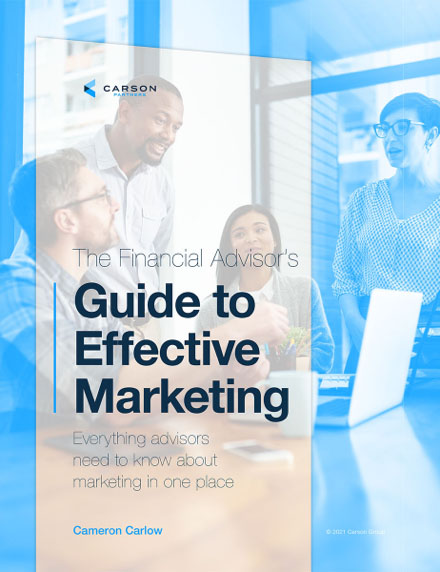There are ample reasons why webinars should be part of a financial advisor’s content marketing strategy – the convenience, the efficiency, the brand-building, to name a few.
A successful, well-thought-out webinar has the power to transform your business.
Clients and prospects can click a link and have direct access to your expertise. No waiting around, no commute, no phone-tag to schedule an appointment.
And a webinar can act as your virtual stage to showcase what you have to offer, build trust and demonstrate your value as a financial advisor.
If you haven’t already incorporated webinars into your content marketing strategy or think your process could use some work, it’s time to start planning. We break down the six steps you need to follow to take advantage of this valuable marketing tool for financial advisors.
Step 1: Determine Your Webinar Topic
Your webinar topic should answer a question your clients are asking. Not only will it provide value to the families you already serve, but it will also likely attract your ideal client, too – because they’ll have the same questions.
And while hosting a webinar is an effective way to offer yourself up as a credible source, it shouldn’t be the sole reason for the webinar. Your goal should be to provide insight people can really use.
Host a webinar that answers questions you’re frequently asked, or highlight your area of specialization – especially when that specialty is a seasonal topic. For example, if you specialize in tax topics, schedule a webinar as tax season nears while it’s at the forefront of people’s minds.
Don’t host a webinar to check a box – “everyone else is hosting webinars, so I guess I should, too” – but instead as a reliable, consistent part of your content marketing strategy.
Don’t host a webinar solely to generate leads.
Your attendees will likely see right through any webinar that’s nothing more than an interactive commercial for your services – especially if you spend a great deal of time urging attendees to forward the webinar to their own contacts.
Complimentary Download: The Advisor’s Guide to Effective Marketing
Step 2: Start the Planning Process
Determine the format and the on-camera needs.
Will your webinar be a solo or joint presentation? Will a moderator ask a panel questions
The sooner you decide on your webinar format, the sooner you can start setting up your outline and, if applicable, inviting guest speakers.
Recruit a support team.
You don’t have to do it all yourself. In fact, it will be better if you have more eyes reviewing your ideas and helping you execute. Assign someone to act as the project manager for your webinar to make sure you get everything done that you need to and when you need to.
Create an attention-grabbing title that is accurate to the content you’ll present.
Get creative and direct with your webinar title. It should grab attention while also setting a realistic expectation for the content you will provide.
- Good: Ready for Retirement? 5 Easy Steps to Prepare (direct and clear)
- Bad: Preparing for the Future You Want (ambiguous)
If you can include SEO words into your title while sounding conversational, do it! If people search online for the same words that are in your title, they may stumble upon the landing page for your upcoming webinar.
Submit your webinar content to Compliance for approval.
You’ll want to complete your webinar content – such as your email invitations and slide deck with speaker notes – with ample time for Compliance to review it, and for you to make any necessary updates and rehearse, so you’re confident ahead of the webinar.
Select the webinar tool/platform.
Popular options with impressive capabilities include Zoom and GoToWebinar; choose the one you are most familiar and comfortable with.
Set up an easy registration process.
Prospective attendees shouldn’t have to jump through a bunch of hoops to sign up for your webinar. Make it as easy as possible for people to sign up and attend. Requiring people to fill out a long form providing lines and lines of personal information to gain access to the webinar will likely turn some people away out of frustration.
Step 3: Get the Word Out
Create your promotional plan.
Decide early how you will get the word out about your upcoming webinar. Set a plan with a reasonable timeline and execute it. Consider what’s worked in the past to prompt action from clients – such as sending an invite via email, posting to social media, etc. – and tap those effective methods.
Encourage guest speakers to tell their followers about their upcoming appearance.
If you’ll have guest speakers at your webinar, encourage them to publicize the upcoming webinar to their own audiences. This is a great way to expand your reach.
Create a landing page that sets the correct expectation.
Your landing page should explain what the webinar is about and how people can register to attend. Make sure the landing page answers any logistical questions.
Invite prospects in your email list with a webinar announcement email send.
Don’t limit your webinar to current clients. Use your webinar to show prospects that you’re an active and knowledgeable advisor.
Watch: Utilizing Webinars To Enhance Your Marketing Strategy
Step 4: Prepare Properly
Plan engaging visuals for your slide deck.
Don’t rely on only text. Make your presentation more interesting and engaging with Compliance-approved visuals.
Write an outline to use as a compass.
You probably “know your stuff,” but sometimes even the most knowledgeable people lose their train of thought when put on the spot. A loose script with important talking points can serve as a guide to keep you on track.
Reserve your space, check your equipment and account for distractions.
Your space should be free of interruptions. Having an extra computer “just in case” with ample charging cords ready is a great option.
If you’re conducting the webinar from your home office, ensure everyone at home knows not to interrupt you or make loud noises outside your office.
Schedule a practice session including audio and video checks.
A practice session can reveal any potential issues so they can be corrected before your webinar.
Meet with your guest speakers in advance to make sure everyone is on the same page.
If guest speakers will co-present during your webinar, communicate your expectations, technology requirements and any other important items.
Step 5: During the Webinar
Plan for glitches and be prepared. A support person should be ready to troubleshoot or fix any problems that may arise.
Here are some quick tips on making the webinar run smoothly:
- Be punctual!
- Don’t start with “Good morning!” or “Good afternoon!” to account for webinar-replay watchers.
- Opening with a personal story pertaining to the content that will grab the audience’s attention.
- Use a headset or other audio method – don’t rely on a laptop’s built-in microphone.
- Stand while presenting.
- Enlist a “spotter” to attend the webinar and let you know via private message if there are any problems in the viewing experience.
- Keep a clock nearby to stay on schedule.
- Encourage audience engagement and keep their attention with verbal commands like, “Look at these statistics!”
- End the webinar with a call to action.
Step 6: After the Webinar
Follow up with attendees.
Find out if they have any questions or if they’d like to set up a consultation to delve deeper into the topic.
Share the webinar on your social pages and with your email list.
Submit the recording of your webinar to compliance and archive the webinar chat. Once approved, l– or how to register for your next webinar.
Consider repurposing your webinar into new, lead-generating content.
Host your webinar recording on your website with an accompanying blog, post the video to your YouTube channel, create smaller clips of impactful moments and share to social media, grab actionable tips from the discussion and create social media quote graphics. Look for any opportunity to make the most of the work you’ve already done to round out your content marketing.
Document your webinar process to make the next webinar easier to put together.
A guidebook of webinar best practices will be a great help when it comes time to pull together another webinar. Include what worked, what didn’t and what you wish you had done differently.
Want to know more about what’s driving the success of today’s fastest-growing financial advisors? Subscribe to Carson’s newsletter, The Trend Line.


